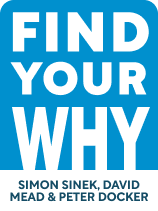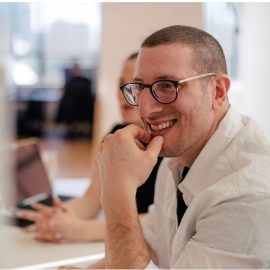

This article is an excerpt from the Shortform book guide to "Find Your Why" by Simon Sinek, David Mead, Peter Docker. Shortform has the world's best summaries and analyses of books you should be reading.
Like this article? Sign up for a free trial here .
What is Simon Sinek’s Golden Circle example? How should leaders use Sinek’s model?
Simon Sinek’s Golden Circle example was introduced in his popular 2009 TED Talk. Aside from being a motivational speaker and author, Sinek also helped others find their purpose by working directly with individuals and organizations.
Keep reading to learn about purposeful leadership using Simon Sinek’s Golden Circle example.
Simon Sinek’s Golden Circle
Simon Sinek’s Golden Circle example was introduced in his book, Find Your Why. In the book, Simon Sinek, David Mead, and Peter Docker lay out the steps individuals and organizations can take to discover their purpose and strengths and share them with the world. Discovering your unique purpose—your Why—and strengths helps you find fulfillment at work and in life. When you live in alignment with your purpose, you make better career decisions and inspire people to join you, whether as part of your team or supporters of your mission.
The Three Circles Explained
Simon Sinek’s Golden Circle example consists of three concentric circles, each representing one of the core concepts in his theory.
1. The inner circle is the Why: the purpose that orients everything you do. It’s the core belief that motivates you to get out of bed in the morning. In terms of an organization, it’s the mission you stand for and the reason you’re in business. An organization’s Why might be to provide accessible health care to its community. An individual’s Why might be to create spaces for learning.
2. The middle circle is the How: the methods and practices that characterize you and which other people consider your strengths. Individuals and organizations can have multiple “Hows” because they are practical, operational knowledge that brings the Why to life. An organization’s How might be to empower the voices of team members. An individual’s How might be to forge meaningful connections.
3. The outer circle is the What: the outputs you generate. It’s the tangible part of your organization or life and the easiest to identify. An organization’s What includes its products, services, policies, and strategies. An individual’s What might be their family, job, and projects.
(Shortform note: Critics point out that Simon Sinek’s Golden Circle example is missing a critical question: Who? They argue that organizations that begin with Why overlook the most important element in a business: the customers. An organization might have a compelling Why, driving its How and What. But if the organization can’t find a customer interested in its product or service (the What), it won’t succeed. Thus, you could complement Sinek’s model by asking yourself who you’re serving and what they need before considering Why you do what you do.)
Golden Circle Example: Simon Sinek’s Purposeful Leadership
According to Simon Sinek’s Golden Circle example, he believes most organizations and individuals work from the outside of the model in. This makes it easier to explain your What and How (results and methods) than your Why.
But Sinek believes great companies start with the core (Why) and work their way outward. He advocates not only focusing on your purpose, but also sharing it upfront with the people you do business with, because revealing what’s driving you fosters long-term relationships. Here’s an example of how the three methods of presenting yourself (leading with What, How, or Why) compare:
Example of Leading with What, or outcomes: You introduce yourself or your organization by talking about your product or service. Some people decide to buy from you, hire you, or join you—but only for as long as you’re the most convenient option available.
Example of Leading with How, or methods: You introduce yourself or your organization by talking about the methods or practices that set you apart from the competition. Some people choose you—until your way of doing things catches on, and you become one of many similar options with the same How.
Example of Leading with Why, or purpose: You introduce yourself or your organization by talking about your mission, the problem you’re trying to solve, or a fundamental belief you have about the future. More people choose you because they understand that supporting you means supporting that purpose. Other competitors might offer similar outcomes or methods in the future, and maybe even with more convenient terms, but you will always have the advantage of the emotional connection you forged.
(Shortform note: The concept of leading with your purpose isn’t new to sales. In To Sell Is Human, Daniel Pink recommends a model based on trust, an interest in serving the customer, plus purpose. His two rules for service-oriented selling are to make it personal and to make it purposeful. He says you’ll be most successful when serving a purpose that improves society.)

———End of Preview———
Like what you just read? Read the rest of the world's best book summary and analysis of Simon Sinek, David Mead, Peter Docker's "Find Your Why" at Shortform .
Here's what you'll find in our full Find Your Why summary :
- Simon Sinek’s steps to understanding and living your purpose and your organization’s
- How to create and write your purpose statement
- What to do after you find your Why: Determine your How






